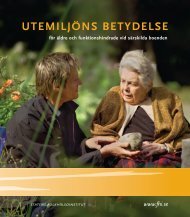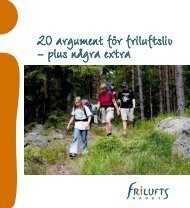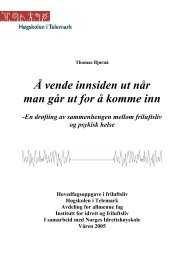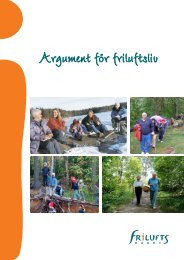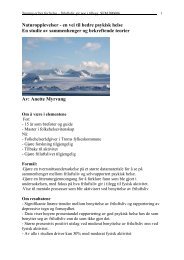Green Care: A Conceptual Framework - Frisk i naturen
Green Care: A Conceptual Framework - Frisk i naturen
Green Care: A Conceptual Framework - Frisk i naturen
You also want an ePaper? Increase the reach of your titles
YUMPU automatically turns print PDFs into web optimized ePapers that Google loves.
positively responded to that environment, hence rapid recovery in the<br />
natural (restorative) setting from the effects of stressful stimuli would be an<br />
evolutionary advantage.<br />
In a much cited study, Ulrich showed that patients recovering from<br />
cholecystectomy (gall bladder surgery) fared better if they had a view of<br />
trees from their hospital bed than if that view was of a brick wall (Ulrich,<br />
1984). Subsequently (Ulrich et al, 1991) he observed that subjects’ heart<br />
rate and EMG (electromyogram) recovered more rapidly from the effects<br />
of watching a stressful film with scenes of simulated injury if they viewed<br />
a video of natural scenes rather than scenes of traffic or a pedestrian mall.<br />
This was consistent with earlier work which suggested that the initial<br />
response to a natural environment is the result of rapid changes in the<br />
physiological and psychological state (Ulrich, 1983).<br />
Kaplan (1995) proposed a model which integrated attention fatigue<br />
within the stress mechanism. In this model attention fatigue can lead to<br />
the stress response; it can occur as a result of the stress response or it can<br />
occur alongside the stress response as a result of an aversive stimulus. It<br />
is likely, therefore, that a number of complex psychological mechanisms<br />
are involved during the process of stress and attention fatigue and are at<br />
work within ‘restorative environments’ and experiences. These mechanisms<br />
may explain why horticulture and gardening, for example, are popular in<br />
rehabilitation even though other activities may well provide opportunities<br />
for the development of manual dexterity, group and social skills. Thus the<br />
preference for a natural environment and interaction with it in the form<br />
of agriculture, horticulture, gardening or other forms of green care may<br />
stem from evolutionary origins in addition to culturally-modified learned<br />
behaviour.<br />
References<br />
Kaplan, S. (1995) ‘The restorative benefits of nature: toward an integrative framework’. Journal of<br />
Environmental Psychology, 15, 169-182.<br />
Ulrich, R. S. (1983) ‘Aesthetic and affective response to natural environment’. In I. Altman and J.F.<br />
Wohlwill (eds.) Human Behaviour and Environment: Behaviour and the Natural Environment, 85-125,<br />
New York: Plenum Press.<br />
Ulrich, R. S (1984) ‘View through a window may influence recovery from surgery’. Science, 224, 420-<br />
421.<br />
Ulrich, R. S., Simons, R. F., Losito, B. D., Fiorito, E., Miles, M. A. and Zelson, M. (1991) ‘Stress<br />
recovery during exposure to natural and urban environments’. Journal of Environmental Psychology,<br />
11, 201-230.<br />
75







